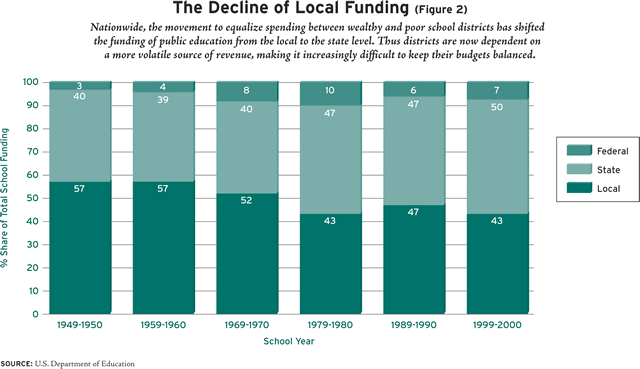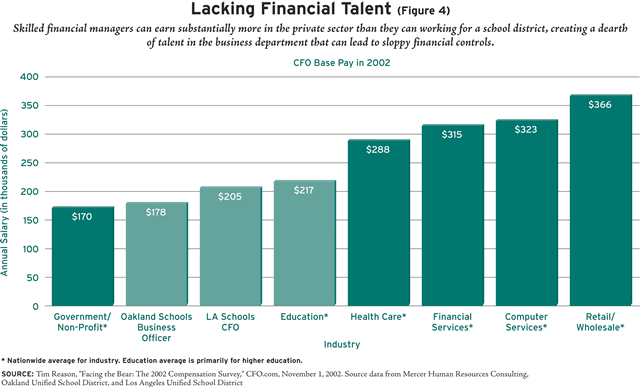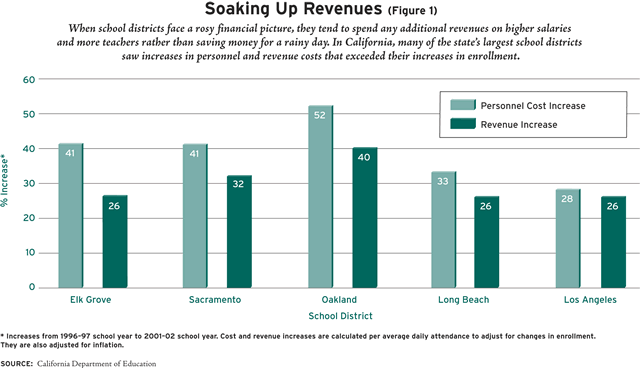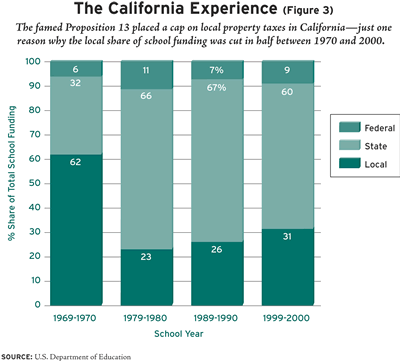 |
In April 2003, Joseph Olchefske, a nationally recognized reformer, announced his intention to resign as superintendent of the Seattle Public Schools. Surprisingly, given his background in investment banking and his previous experience as the school district’s chief financial officer, Olchefske was felled by a financial crisis. In the fall of 2002, the school district had discovered an unexpected $23 million deficit for the previous fiscal year. The district was on track to ledger another $12 million deficit for the 2002-03 fiscal year.
About a month later, Dennis Chaconas was fired as superintendent of the Oakland, California, public schools. New software, installed so that the school district could better understand its finances, had uncovered a $40 million deficit from the previous year. The deficit for the current year was expected to be equally large. To keep the district solvent, the state of California provided a $100 million line of credit and took over the district’s operations, stripping the school board of all but advisory powers and appointing an administrator to replace Chaconas. Although Oakland had long been known as a troubled school district, it had appeared to be moving in the right direction under Chaconas. Teacher turnover was down and test scores were up.
Unlike the financial chicanery that doomed corporate titans like Enron and WorldCom (now MCI), intentional corruption does not seem to have been behind either of these crises. Deliberate malfeasance has played a role in many a school district’s financial distress (as in Compton, California), but Seattle and Oakland fell into difficulty while they seemed to be on the upswing. Why can even school districts that are apparently healthy suddenly find themselves on the verge of insolvency? This question will become increasingly urgent in the coming months, given the grim budget outlook that most states are facing. The problem is particularly acute in California (the primary focus of this article), where the state government, which largely dictates K-12 spending, is in the midst of a financial crisis.
The specific path to financial distress is, of course, unique in each case. Any number of factors, from excessively generous concessions at the bargaining table to a fiscal crisis at the state level, can throw a district into financial turmoil. The common way of dealing with these crises is to focus on the immediate causes of financial distress and to treat them as a straightforward management problem. However, such crises are more properly understood as the result of underlying political and legal realities that prevent districts from managing their finances properly.
Four general factors can interact to create financial instability. First, the dynamics of public funding and the budgeting process encourage school districts to spend their entire funding allocation, creating a cost structure that is difficult to adjust down when revenue drops or fails to grow at an expected rate. Second, districts are constrained in how they can spend money and in the financial engineering options open to them. Third, the lack of attention afforded to the nuts and bolts of financial management in K-12 public education can result in naïve oversight and inadequate management-information systems that can delay appropriate responses to emerging financial crises. Finally, school district finances are lodged within a larger political environment. Politicians and state officials may find ways to help push districts over the financial edge in order to accomplish their own purposes.
The Downsides of Incrementalism
Given that school districts largely do not have to face the vagaries of “selling” their services to fickle consumers, one might think that balancing the budget would be fairly straightforward. Not so. The typical district has a budgeting process that results in its permanently “living on the edge,” with revenues just matching costs. When hard times arrive, it is difficult for districts to adjust for a variety of reasons.
The first reason is the use of incremental budgeting. That is, school districts generally determine their current year’s budget by taking the previous year’s budget and adding or subtracting incremental spending to each major item. By contrast, zero-based budgeting asks managers to examine the services they are required to deliver and then build up their cost structure from scratch. Another strategy, activity-based costing and its derivatives, separates the costs of various activities within a business. Then, by looking at external benchmarks and generating ideas internally, managers search for ways to reduce the costs of these activities while delivering the same level of service (if such a level of service is even needed). The goal of using these budgeting methods is to ensure that the organization aligns its costs with its strategy and most valuable activities.
The downsides of the incremental approach are obvious when they are compared with methods that are more tightly focused on value. Making piecemeal changes to district priorities through a fragmented series of increments based on last year’s budget will not ensure that the organization is carrying out the strategically correct activities or that it is executing them in a cost-effective manner. Thus when cuts need to be made, in the name of “fairness” they are often imposed as flat percentage cuts to each department across the board, ignoring both the relative efficiency and the relative importance of various departments. This method in fact provides an incentive for inefficiency: the fatter a department gets, the better it can survive the inevitable budget cycles.
Nevertheless, as the political scientist Aaron Wildavsky pointed out years ago, the incremental approach has a lot going for it in the governmental sphere. First, it is simpler than the other approaches. Large urban school districts are complex, multilevel organizations with hundreds of sources of revenue, each with its own set of requirements and constraints. During the 2001-02 school year, the Los Angeles Unified School District received funding from well over 200 federal and state grants and entitlement programs. Any attempt at zero-based budgeting would require decisionmakers to understand and work within the constraints imposed by these funding streams, each of which is typically earmarked for a specific group of students or a particular school program. Much of the remaining money is devoted to salaries, largely for teachers. In short, most of the school district’s funding is already spoken for. This makes zero-based budgeting or even activity-based costing almost pointless from a budget officer’s point of view, since so little of a district’s funds are available for reallocation.
These value-oriented reviews can also be dangerous for managers in the public sphere to undertake. School boards and superintendents are justifiably hesitant to mobilize too many stakeholders against them at once by saying, “Let’s rethink our whole approach.” In normal years, the incremental approach enables district leaders to limit the political stresses around budgeting by focusing on a few specific changes. As a result, the incremental approach is likely to lead a long and healthy life in school district budgeting. Unfortunately, this also means that school districts will be exposed to all the flaws of incrementalism: spending patterns that are poorly aligned to strategic priorities; fragmented educational programs; and little ability to quickly restructure resources across departments and schools.
Use It or Lose It
School districts also face strong incentives to spend their entire funding allocation in any given year. In the private sector, profits are good. They can be used to grow the business, to provide a cushion during downturns, or to reward investors. School districts, however, are reluctant to generate surpluses (the public sector’s analogue for profits). Like most government agencies, school districts operate under conditions of “use it or lose it.” The assumption is that if they don’t spend the money, they didn’t need it. Even if a school district were to control its costs enough to generate a significant surplus, the extra funds would immediately become a target for outside interests. Large surpluses suggest to politicians that too much money is being put into the schools and to unions that too little is being paid to teachers.
For instance, in 2002, after a spring of difficult cost-cutting, administrators in Los Angeles discovered that the school district had a substantially larger ending balance than projected. The union saw this as proof that the district could afford raises for teachers and that some unpopular budget cuts, such as increases in class size, were unnecessary. In the spring of 2003, union-backed candidates ousted two incumbent school board members. This was the result of several factors, but the previous year’s budget cuts and unexpectedly large ending balance played a significant role in mobilizing the union. It is thus little wonder that districts attempt to “kiss” a zero or a statutorily established minimum balance every year.
The most popular way of soaking up excess revenues is to increase salaries and to hire additional school personnel, especially in districts that have difficulty attracting and retaining qualified teachers. Thus in June 2000, during the best of financial times for California, the Oakland school district gave teachers a 24 percent salary increase (in addition to the normal step increases). While increasing teachers’ salaries pleases teachers and their unions, hiring additional teachers makes class sizes more manageable, pleasing parents and teachers alike. Moreover, reductions in class size are at times encouraged by the state through significant financial support, as in California. As a result, districts’ personnel costs tend to keep pace with growth in district revenues. For example, during the five-year period from 1996-97 to 2001-02, increases in personnel costs outstripped increases in district revenues in 14 of the 20 largest California school districts (see Figure 1). While such changes are politically popular and can improve a district’s ability to recruit qualified teachers, they are difficult to reverse. Personnel costs are notoriously “sticky”–easy to increase but hard to reduce.
Slippery Revenues
The problem with building up costs to match revenues is that school districts do not generate their own revenues and cannot control their service obligations.
At one time, the majority of school funds came from the local community in the form of property taxes. The movement to equalize spending among rich and poor communities changed all that. In 1950 localities provided about 57 percent of the revenues available to school districts. By 2000 their share had dropped to 43 percent (see Figure 2). Even this significantly understates the decline in local influence over school district revenues. Many states, including California, Florida, and Texas, either place caps on local property-tax rates or redistribute property-tax receipts when they exceed a certain level. Localities cannot simply raise property-tax rates to the level they feel is necessary to fund the schools.

The situation has reached an extreme in California. First, the California Supreme Court’s 1971 Serrano decision required the state to make school spending between rich and poor districts more equitable. Second, Proposition 13, which the voters passed in 1978, placed a cap on property taxes. Finally, in 1988, Proposition 98 required the state to spend a minimum amount of the general fund on education. As a result, the share of school spending from local revenues dropped from 62 percent in 1970 to 31 percent in 2000 (see Figure 3). With no real power over revenues, local school boards in California face little incentive to conserve on costs as a means to lower tax rates.
K-12 education is the largest line item in most state budgets, representing 22 percent of total state spending and more than a third of general fund expenditures (money that comes from state taxes and is not earmarked for specific purposes). Thus school district funding is tied to the sources of state general funds–typically receipts from sales taxes and income taxes. In turn, these receipts are closely tied to state economic conditions, even more closely than property taxes are. Therefore, when states face significant deficits, funding for education must be cut. And, unlike some other government agencies, which can choose to reduce services by letting roads go unpaved, releasing prisoners early, or turning away indigents in search of health care, the schools cannot simply stop educating kids. They must serve all students within their area, and they have a multitude of mandates they must fulfill whatever their funding situation.
When an economic downturn hits, school districts suffer revenue cuts, but cutting costs is difficult. The typical district spends more than 80 percent of its revenues on salaries and benefits, and salaries tend to ratchet only one way–up. In addition, as Michael Podgursky recently noted in these pages (see “Fringe Benefits,” Check the Facts, Summer 2003), districts often provide generous defined-benefit plans to both current employees and retirees. With double-digit annual increases in health-care expenses, the relative cost of benefits to school districts can be expected to rise substantially. What’s more, many school districts have almost unlimited obligations to provide health benefits to their retirees. In 2002, the Los Angeles school district had estimated liabilities of $4.8 billion in unfunded benefits for its current and future retirees, an amount greater than the value of its net assets.
A final complexity in the district budgeting process comes from its timing. Many school districts are required to settle on a budget before they know what their revenue will be. In the spring of 2003, due to a large projected deficit and the difficult cuts it implied, the state of California had not adopted a budget by July 1, the deadline for school districts to turn in their budgets–budgets that are based, theoretically, on the funding elucidated in the state budget. This places a further brake on school boards’ ability to cut costs aggressively. It can be hard for board members to justify taking political heat for unpopular cuts before knowing exactly how large the revenue gap will be.
When a Dollar Is Not a Dollar
One of the fundamental principles of financial management in the private sector is that money is fungible. In other words, a dollar received as revenue from a customer can be used for many things. Part of it pays for the good or service received by the customer. But the profit from that revenue may also be reinvested in the company or paid out to shareholders and to the firm’s employees.
By contrast, large public school districts receive a substantial portion of their revenues in the form of categorical or restricted funds. Each of these revenue streams has strict limitations on how the money can be spent. For instance, federal Title I funding for compensatory education must be spent only on low-performing students, unless the entire school qualifies as a Title I school. From the legislator’s point of view, this makes perfect sense: legislation was enacted and programs created with the intent of targeting a particular group or solving a particular problem. Such monies are intended to “supplement, not supplant” existing district expenditures.
District managers, however, are faced with a crazy quilt of funding streams for purposes that match the district’s strategic priorities only by happenstance, if at all. In order to achieve the district’s goals, good managers will attempt to find ways to use categorical and restricted monies that are not in line with the district’s aims to free up other funds that can then be used to pursue its priorities.
The result is what I will call the “dance of supplantation.” District managers attempt to use restricted, categorical funding to free up unrestricted, general-fund monies while the providers of revenue attempt to prevent them from doing so. Managers performing this dance with too much gusto can suddenly find they have danced over a cliff. Money they were counting on being able to use might be withheld. Worse, money they have already spent may need to be paid back. For instance, in 1991 the Richmond Unified School District in California went bankrupt. One of the contributing factors was superintendent Walter Marks’s overly aggressive repurposing of funds. The district found that it had to repay the state for $4 million that had been earmarked for desegregation efforts and then inappropriately spent.
The dance of supplantation takes on special importance when districts enter times of financial crisis. Unlike private businesses, where a surplus in one division can provide cash for the whole company, districts cannot typically use, say, their surplus nutrition funds to pay for instruction, or vice versa. During the recent financial crisis in Oakland, one of the strategies proposed by the board and superintendent was to repurpose bond monies intended for construction to the general fund, in repayment for general-fund monies already spent for construction. Perhaps not surprisingly, the state attorney general disallowed this maneuver. This took away Oakland’s last alternative to a state loan and takeover.
In California, districts are further constrained in that they do not have full access to their reserves. Districts are required to deposit reserves with their local counties to prevent them from foolishly investing the funds. (Until 1994, nothing prevented the counties from making foolish investments. That’s when Orange County lost its school districts’ funds as well as its own after a series of highly speculative trades plunged the county into bankruptcy.) In addition, some special funds held by the county, such as workers’ compensation, cannot be used for other purposes once the district has paid into them. So even if a district has overfunded a particular reserve, it does not have access to that money in times of need. While this eliminates the temptation to raid funds for short-term gain, it also places limits on districts’ financial flexibility. When a district finds itself in financial trouble, it must respond with one hand tied behind its back.
The Perils of Instructional Leadership
While the budgeting and finance issues discussed above make it easy for districts to get into financial trouble, poor financial management skills among district staff and incomplete information flow can turn what would have been a painful budget-cutting exercise into insolvency.
It begins at the top. While public companies can ensure that their boards of directors are stocked with financial know-how, this is not possible for elected school boards. As a result, many school boards lack basic financial literacy. The complicated structuring of district revenues and the lack of single, consolidated financial reports further undermine board members’ ability to monitor the financial situation. Finally, the frequent turnover of boards and superintendents limits institutional memory. Any expertise board members have accumulated is lost as they move on.
Moreover, boards tend to hire superintendents who may not have a deep level of financial expertise themselves. In the private sector, CEOs are expected both to provide strategic direction for a company and to ensure that the finances are in order. Business leaders would scoff at the idea that the financial side of a business should be isolated from the production side. In the world of education, however, the ability to provide “instructional leadership” is considered separate from and more important than mere financial management. This can result in weak financial oversight. Dennis Chaconas, the former superintendent in Oakland, admitted that he relied on others to deal with the financial aspects of the district. “I concentrated on academics,” he told the Oakland Tribune. “I thought that was the most important issue facing the district.” In Seattle, Moss Adams Advisory Services, brought in to determine what went wrong, noted that the explicit “kids first” focus of the district resulted in an organizational culture that did not take financial management seriously enough–despite the superintendent’s considerable experience with finance. Such an environment can result in middle managers not being held accountable, even if they fail to stay within budget or to make needed cuts.
Compounding the naïveté of top management can be a general dearth of talent in the business departments themselves. While there are many fine CFOs and business managers in America’s school districts, the overall pool of talent in the finance department is not comparable to the private sector. The reasons are not hard to discern. First, many critical business managers in large school systems rose into these positions “through the ranks” and may have started out in an unrelated position, such as teacher or principal. While such an organic process of “growing your own” can result in strong employees who know the specific issues and details of their district, these employees have not been exposed to approaches outside of the closed world of education and have not gone through the professional crucible of working for a large accounting firm, as many private-sector managers do. As a result these administrators may inherit inefficient and tremendously outdated processes with no clear ideas on how to improve them.
Second, it is not even clear why business managers from the private sector would want to work for a school district. As discussed above, financial management (and human-resources management and information-technology management) is typically not considered a “core” activity for a district. Moreover, it is often politically difficult to pay such managers substantially more than managers on the instructional side of the district. The result is that good business managers can get a lot more money doing the same job outside of the public school system (see Figure 4). This is not true of even the finest teachers, who would be hard pressed to find a similar teaching job at a greater salary outside of a public school. Unless and until school districts are willing to pay competitive salaries, we can expect them to be short on business talent.

Since information technology is not considered a core activity either, large school districts are notorious for having antiquated information systems. Large private companies with thousands of employees will typically have accounting and personnel systems that connect the budget to ongoing financials to human resources to operations to sales. The technology behind such systems is generally based on a few standard platforms (SAP, PeopleSoft, Oracle) and installed by a major IT service provider (IBM Global Services, Accenture).
School districts, however, often have multiple, cobbled-together systems developed over a long period of time and based on nonstandard architecture. As a result, budgeting systems do not connect automatically with accounting systems, and both may be isolated from the human-resources systems that track who is hired, when, and for how much. The combination of weak financial expertise and outdated IT systems results in problems being uncovered late and critical degrees of freedom being lost. Unless departments devote substantial time and effort to coordinating data flow, it is easy for the number of people hired to exceed the number of positions in the budget. Overspending can continue undetected for months. Oakland provides a dramatic example of this, discovering that it was in trouble only after it was already $40 million in the hole. At this point, Oakland was already underwater and, unless the district were able to free up other restricted monies, it would ultimately need a bailout.
The fix is to install newer and more-integrated IT systems. This can be quite expensive (potentially more than $100 million for the largest districts) and is an easy political target. Interested parties might want to spend the money required on teacher salaries rather than on expensive new systems for the district bureaucrats.
The Usefulness of Insolvency
School districts are unavoidably part of a larger political environment. Cities, counties, and state legislators and regulators all have political interests in the schools that may or may not line up with the interests of a school district’s current board and management. In fact, these outside actors might secretly applaud a district’s financial collapse because of the opportunities it creates.
Although some states have “academic bankruptcy” laws, it is difficult for a district to be taken over for failure of its education system. This is because many factors aside from the quality of a school district contribute to students’ academic performance. Financial mismanagement, however, is much more clear-cut. If a district cannot make payroll or pay its bills, its operations will cease unless someone steps in to provide the needed liquidity. Since schools cannot simply stop operating, as a business would, state or county governments find themselves having to step in to provide a loan to the district. This hands politicians a much more palatable excuse to take over a district than “academic bankruptcy.” Allowing a district management team that has already shown questionable financial judgment to continue in office would put state monies directly at risk.
For instance, in 1995 the Illinois legislature handed the governance of Chicago schools to the mayor at least partly as a result of a massive deficit. Newark, Cleveland, Compton, Detroit, East St. Louis, and Philadelphia have all been the subjects of outside intervention in which fiscal mismanagement was one of the arguments for action. For those in favor of significant changes to district governance or management, bankruptcy can be a good thing.
What Is to Be Done?
Using bankruptcy or severe deficit spending as a tool for gaining control of schools is, unfortunately, quite expensive for the state and for the students. Either the state or the district will have to make up the deficit, and the bankrupt school district will find itself even more financially constrained than before, with today’s students receiving fewer resources on account of yesterday’s mistakes. So what can be done to prevent such occurrences in the future?
First it is important to understand that most of the problems discussed here have been structural issues resulting from how school systems are governed and regulated. As long as school board members are elected, we cannot guarantee that districts will have either the knowledge or the will to manage their finances well. We also cannot eliminate the multitude of political interests and pressures that shape budgeting decisions. Given this situation, there is a set of realistic reforms that states and districts could undertake right now, as well as deeper reforms that would change the very structure of school districts and thus get closer to the roots of the problem.
Let me discuss the more realistic reforms. First, the state and federal finance systems for schools tend to be too complex and impose far too many limitations on how districts can spend their money. The current move toward block grants by state and federal agencies is a welcome one, as it has the potential to allow districts sufficient flexibility to pursue their strategic goals and to reallocate money as needed.
Second, board members should demand of their superintendents both instructional leadership and financial expertise. District leaders should also undertake the appropriate training to make themselves better financial managers. In addition, the leadership should bring in independent outside financial and business experts to monitor district finances before a crisis erupts. States can help districts in this process by requiring financial training for new school board members.
After receiving the appropriate training and hearing from outside experts, school district officials might end the practice of “starving” their business functions in order to focus on instruction and would install IT systems that provided adequate surveillance of the overall operations of the district. These systems should reliably track revenues, positions, and spending on a timely basis.
Finally, districts should develop robust multiyear financial projections and contingency plans that clearly specify how the district will adjust if expected funding does not come through. The projections should incorporate accurate (as opposed to ad hoc or historical) projections of students and staffing requirements. Contingency plans should be made part of salary negotiations.
Now let’s look at some deeper, more structural reforms that could lessen the likelihood of financial crises. First, appointed (as opposed to elected) school boards would eliminate some of the multitude of political interests and pressures that shape budgeting decisions. While such boards certainly provide no guarantee of solvency, whoever appoints the board could ensure that there is an adequate amount of financial know-how present. Of course, such boards also represent a dramatic step away from the relatively direct democratic control of schools that predominates now and that many communities prize. A turn towards appointed boards would be a major, and hotly contested, shift.
Second, choice-based reforms such as charter schools and vouchers, if thoroughly implemented (and combined with more rational state funding), could eliminate a significant amount of the complexity associated with district finances. Each school would need to balance only its own budget. In addition, the closer connection between schools and parents could counteract the upward pressure that special interests exercise on the budget. Most important, individual school-level governance would lower the consequences of financial failure. Unlike school districts, individual schools that pursued only “instructional leadership” to the detriment of fiscal stability could simply go out of business, their place taken by more responsible peers. Unfortunately, if the state does not fund such reforms at the appropriate level or ensure some level of competence on the part of suppliers before they open schools, there may not be enough responsible peers available to pick up the slack.
Of course, a lot more is at stake in each of these structural reforms than better financial management. These reforms will not (and should not) be judged solely on this one dimension, and their political palatability varies dramatically across the country. However, as long as school boards are elected and school districts are political battlegrounds, it will be difficult to ensure that school systems manage their finances responsibly.
-Jon Fullerton is a vice president of the Urban Education Partnership, based in Los Angeles, California.




